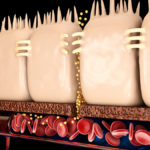By David Blyweiss, M.D., Advanced Natural Wellness
- Finding delicious alternatives to wheat
- The difference between wheat-free and gluten-free
- Resources to make it easier to shop, dine and live wheat-free
The letters have been streaming in since I issued the Resolution Report at the beginning of the year. No wheat?! Now what?
I understand the challenge… I’ve faced it myself. “Breaking bread” together is something most of us grew up with. It is embedded into the cultural – and even religious – thread of our lives.
And it’s not just bread. Wheat is everywhere, in everything. It can feel at first like trying to avoid air or water.
Fortunately, food and allergy awareness is increasing rapidly. This is quickly creating a demand for more options. And since capitalism thrives on demand, more choices are coming down the pike every day.
Here’s a list of wheat options for you to try. You might be surprised to find something you like better than wheat! You never know…
Open your arteries, improve blood flow for a new health miracle...
Did you know your circulatory system has over 60,000 miles of arteries, veins and other blood vessels, if stretched end to end?
But as you age, your blood vessels undergo changes, which may cause them to stiffen, thicken and get clogged.
GOOD NEWS! Doctors have now identified a “Miracle Molecule” inside your arteries that helps OPEN your arteries and IMPROVE blood flow.
It’s what Dr. Valentin Fuster calls it, "One of the most important discoveries in the history of cardiovascular medicine."To you, that means...
- Healthy blood pressure
- Sharper mind and memory
- Skyrocketing energy and muscular strength
- Increased pleasure and passion in the bedroom
- Improved circulation to every cell and organ in your body
Go here to discover a new natural way to significantly boost the levels of this miracle molecule in YOUR body NOW!
Now, before I provide the list of wheat options, I want to make a distinction between gluten and wheat.
Gluten is a protein found in grains such as wheat, barley, rye and others. It is not the grain itself – which is an important distinction. Also, it’s possible to separate the gluten from the grain. So if the label says gluten-free it doesn’t mean the product is wheat-free, and vice versa.
If you have celiac disease or gluten intolerance, you will need to eat a gluten-free diet. But my recommendation is to avoid wheat, specifically. Here’s the problem…
The wheat we eat is not the wheat we ate 50 years ago. It has gone from being an agricultural product, to a scientifically engineered and hybridized food product.
Due to changes in farming methods – designed to make it drought-resistant and more profitable – wheat is practically a loaded weapon. Two slices of bread increases your blood sugar more than two teaspoons of sugar or a candy bar!
While some might argue that grains have always done us more harm than good, today’s wheat is in a class by itself. Due to these changes in production, wheat contains:
The World's Quickest Solution for Ending Prostate and Urinary Misery
This has recently been revealed to be one of the only real breakthroughs in prostate health.
The seeds of a strange fruit (sometimes called "Chinese Apples") hold powerful phytonutrients that are a revolution in prostate health.
In fact, UCLA and Veterans Administration research have now proved this to be true.
Not only that, but it may be the worlds quickest solution for ending prostate misery.
Simply stated, these phytonutrients represent a huge step beyond beta sitosterol, saw palmetto, and other phytosterols alone.
Simply click HERE if you want to have fast prostate relief...restful, uninterrupted sleep...no more constant "urges to go"...enhanced virility...and optimal prostate support for life.
- a hyper-gluten that’s hyper-inflammatory
- a hyper-starch (amylopectin A) that’s hyper-fattening, and as an added bonus,
- it processes into gluteomorphin, which is addictive… and makes you crave more!
Now if you’re ready to go wheat-free, but not grain-free, here are some types of grains to try:
Amaranth: This grain is one of the most common wheat substitutes you’ll find. It contains more protein than wheat, is an excellent source of lysine, and unlike most grains, is highly digestible. You will see amaranth in baked goods and breads that are wheat and gluten-free.
Buckwheat berries: Don’t let the name fool you, this grain is neither buck nor wheat. It is from a plant in the rhubarb family. You will see this grain also as kasha or kashi. It is most commonly cooked into hot cereal. Buckwheat flour is also used in pancakes, bread and soba noodles.
Millet: This grain is popular everywhere in the world but the United States. It can be cooked into breakfast grits and is a good replacement for breadcrumbs in casseroles, croquettes and other side dishes. This happens to be my bread of choice because I like toast, and it tastes great toasted. My local market carries it combined with zucchini or raisins.
Quinoa: Whether you pronounce it keenwa or kwinoa, it is often referred to as a wonder grain. Quinoa is high in protein, easy to digest, and quick to cook. Always rinse and drain it before cooking or it will have a bitter taste. Cook and use as you would rice. It is also found as any number of pastas, from spaghetti to macaroni.
Don’t forget to also add more fruits and vegetables into your diet for fiber and nutrients. And if you are a vegetarian and were counting on grains for protein, opt for quinoa and amaranth as higher-protein alternatives. If you are eating fish and meat, you can stick with rice as a substitute.
And lastly…
Don’t expect to feel better or be happy about it right away!
Making such a major change in your diet can take some time and patience. Going cold turkey is the best way. You will experience cravings for a few days to a week as your body experiences withdrawal symptoms. That’s right – withdrawal. You are as addicted to wheat as any heroin addict is to the next fix.
But after the first few days or so, the cravings will stop. The fog will lift. Some of those other vague aches and pains will vanish. Your low-energy levels will rebound. And the weight will start to come off.
That is, if you stay faithful. Make the effort to go 6 weeks without it. Once you experience the remarkable results, it will be much easier to stay off.
It may take a few tries. It may make you grumpy for a few days. But it will also be one of the best steps you can possibly take for your long-term health.
Here’s an online resource that might be able to help you make smart choices at restaurants.
And don’t forget to buddy up on your health commitments. One of you might find a great wheat-free dish at a neighborhood restaurant. The other might find the perfect loaf of bread.
Eventually, you’ll find that “breaking bread” works just as well without the wheat. In fact, better.







Thank you❤?